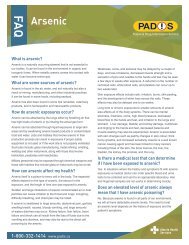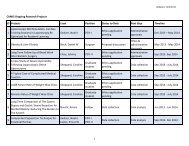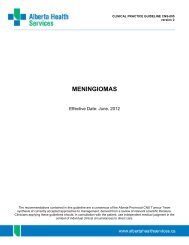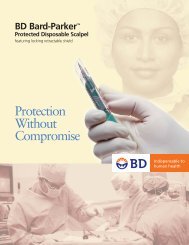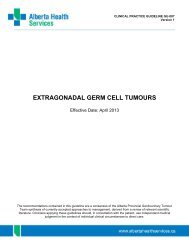Chronic Lymphocytic Leukemia - Alberta Health Services
Chronic Lymphocytic Leukemia - Alberta Health Services
Chronic Lymphocytic Leukemia - Alberta Health Services
Create successful ePaper yourself
Turn your PDF publications into a flip-book with our unique Google optimized e-Paper software.
Second-Line Treatment Options:<br />
CLINICAL PRACTICE GUIDELINE LYHE-007<br />
Version 2<br />
8. In fit patients, FCR is an effective regimen for rituximab naïve patients or FC. Re-treatment with FCR<br />
is a reasonable treatment option for patients experiencing a long remission (more than two years)<br />
after initial FCR treatment.<br />
9. The combination of fludarabine and low-dose alemtuzumab (FluCam) is a safe and effective therapy<br />
for relapsed/refractory CLL and has been demonstrated to improve PFS and OS compared to<br />
monotherapy with fludarabine.<br />
10. In frail patients, fludarabine or chlorambucil are reasonable second-line treatment options. If the initial<br />
remission is greater than 1 year, re-treatment with the initial chemotherapy agent is recommended. If<br />
the initial remission is shorter than 1 year, treatment with a different second-line agent is indicated.<br />
11. Allogeneic stem cell transplantation may also be considered for fit patients who are younger than 65<br />
years of age and who have not responded to therapy, have progressive disease within 1 year of<br />
fludarabine treatment or within 2 years of fludarabine-based combination treatment, or those whose<br />
CLL possesses del(17p) and require treatment.<br />
12. Chemo-sensitivity should be demonstrated prior to stem cell transplantation. Several small studies<br />
have reported encouraging response rates after treatment with high dose corticosteroids in patients<br />
with refractory CLL or in patients with del(17p).<br />
Follow-up and Supportive Care:<br />
13. Patients with CLL often have compromised immune systems due to either the disease itself and/or the<br />
associated treatments. Antibiotic prophylaxis and regular vaccinations are recommended, depending<br />
on the type of treatments administered. PCP and anti-viral prophylaxis are strongly recommended for<br />
all patients receiving FCR or FluCam. Patients treated with alemtuzumab should also be screened for<br />
CMV reactivation with weekly CMV PCR.<br />
14. Special attention should be paid to the appearance of autoimmune cytopenias, such as autoimmune<br />
hemolytic anemia, immune thrombocytopenia purpura, and pure red-cell aplasia, which occur in up to<br />
11 percent of patients with CLL.<br />
DISCUSSION<br />
I. Diagnosis<br />
CLL is described by the World <strong>Health</strong> Organization (WHO) as a neoplasm composed of monomorphic<br />
small, round-to-slightly irregular B-lymphocytes in the peripheral blood, bone marrow, spleen, and lymph<br />
nodes, admixed with prolymphocytes and paraimmunoblasts forming proliferation centres in tissue<br />
infiltrates. (1) According to the 2008 International Workshop on CLL (IWCLL) guidelines, the diagnosis of<br />
CLL requires a circulating B-lymphocyte count greater than or equal to 5 x 10 9 /L in the peripheral blood,<br />
for the duration of at least 3 months. (3) Although CLL and small lymphocytic lymphoma (SLL) are<br />
categorized by the WHO as similar entities, the term SLL is used to indicate neoplastic tissue infiltration in<br />
lymph nodes, spleen, or other organs associated with a circulating B-lymphocyte count that does not<br />
exceed 5 x 10 9 /L. (1)<br />
Page 4 of 23



